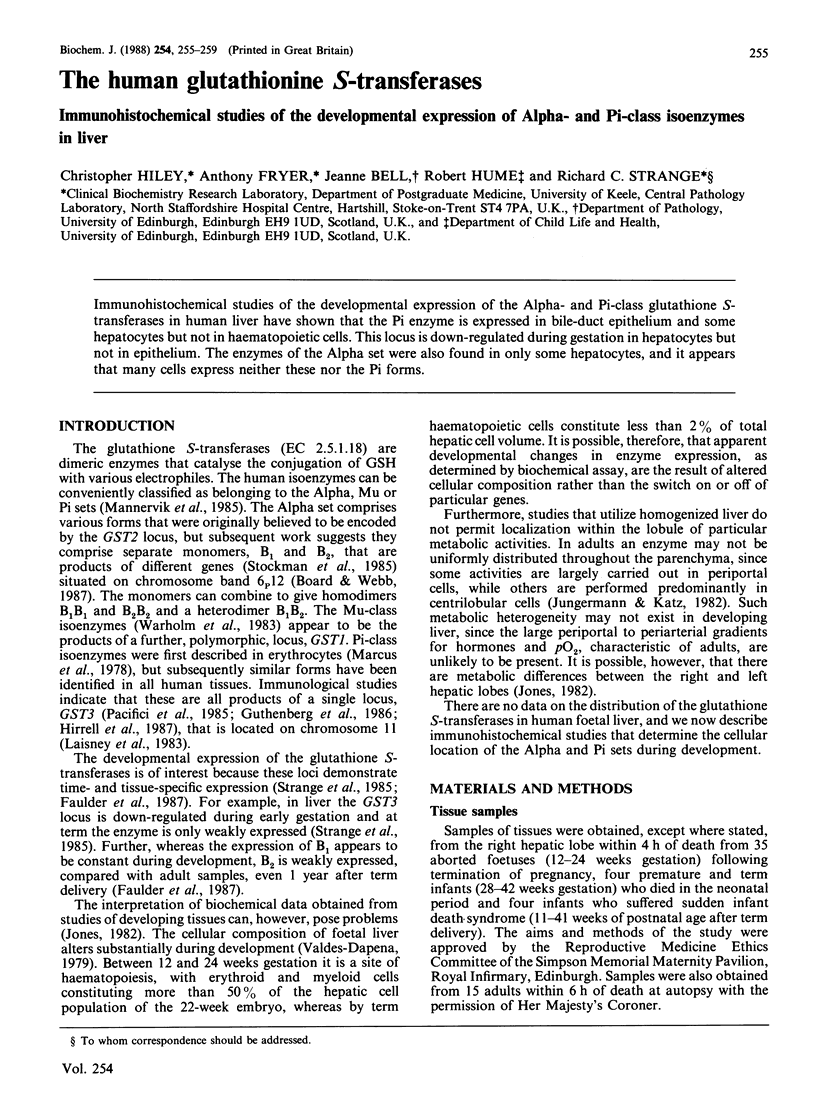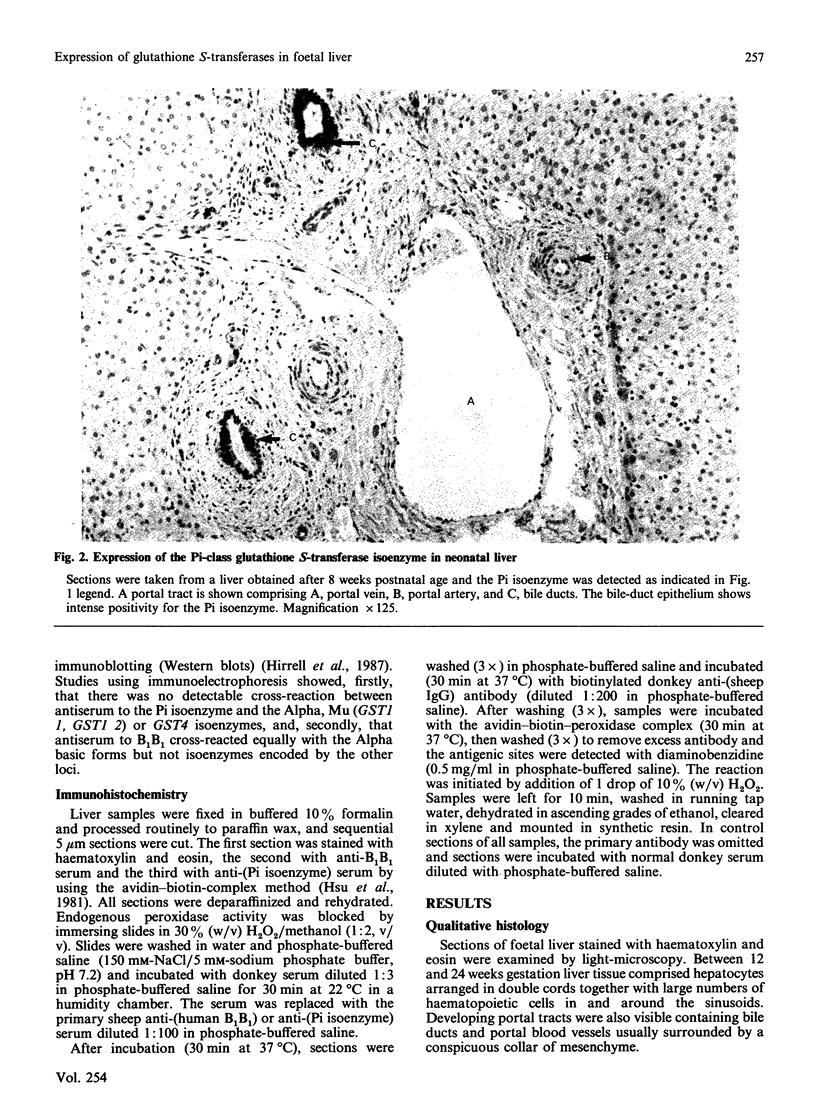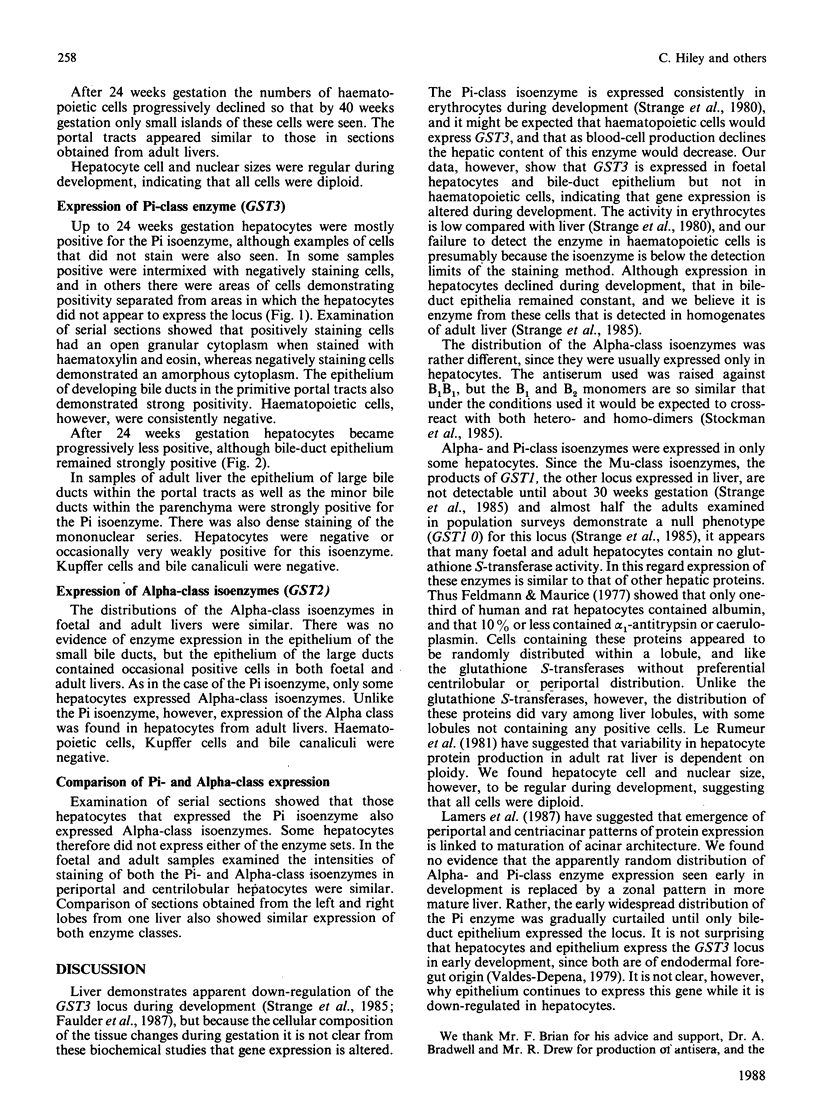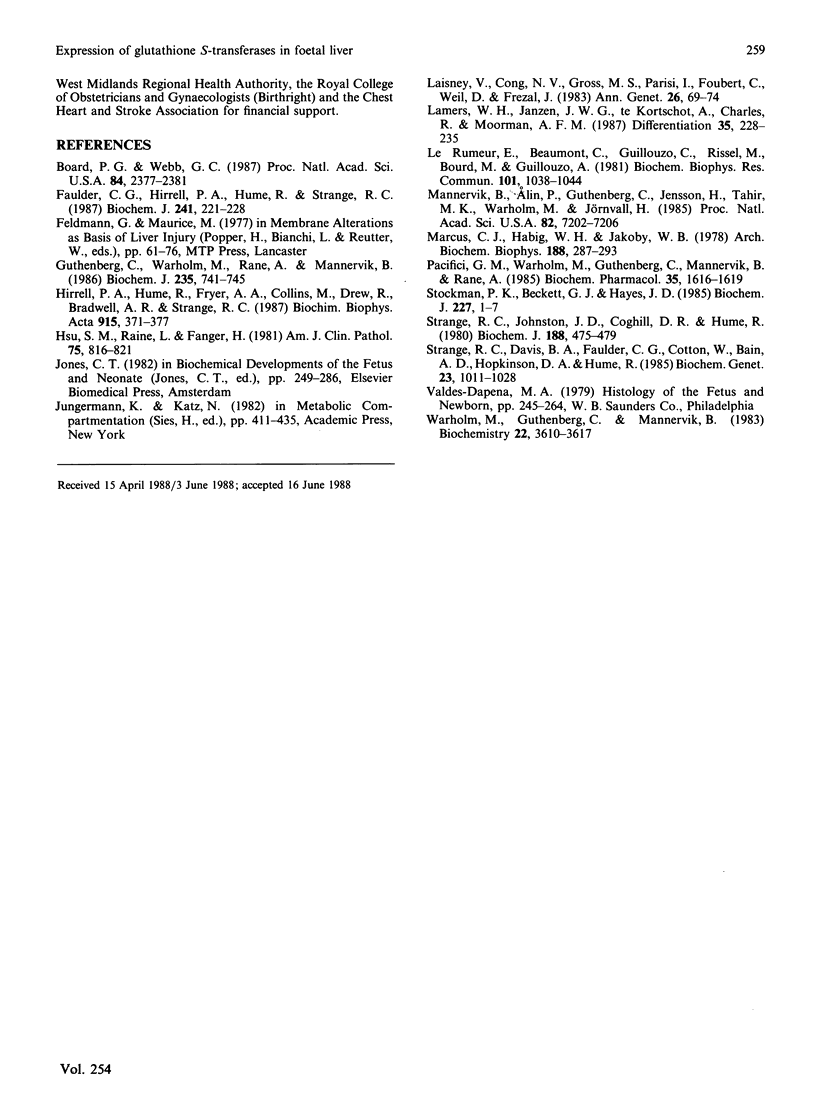Abstract
Immunohistochemical studies of the developmental expression of the Alpha- and Pi-class glutathione S-transferases in human liver have shown that the Pi enzyme is expressed in bile-duct epithelium and some hepatocytes but not in haematopoietic cells. This locus is down-regulated during gestation in hepatocytes but not in epithelium. The enzymes of the Alpha set were also found in only some hepatocytes, and it appears that many cells express neither these nor the Pi forms.
Full text
PDF




Images in this article
Selected References
These references are in PubMed. This may not be the complete list of references from this article.
- Anner B. M. The receptor function of the Na+, K+-activated adenosine triphosphatase system. Biochem J. 1985 Apr 1;227(1):1–11. doi: 10.1042/bj2270001. [DOI] [PMC free article] [PubMed] [Google Scholar]
- Board P. G., Webb G. C. Isolation of a cDNA clone and localization of human glutathione S-transferase 2 genes to chromosome band 6p12. Proc Natl Acad Sci U S A. 1987 Apr;84(8):2377–2381. doi: 10.1073/pnas.84.8.2377. [DOI] [PMC free article] [PubMed] [Google Scholar]
- Faulder C. G., Hirrell P. A., Hume R., Strange R. C. Studies of the development of basic, neutral and acidic isoenzymes of glutathione S-transferase in human liver, adrenal, kidney and spleen. Biochem J. 1987 Jan 1;241(1):221–228. doi: 10.1042/bj2410221. [DOI] [PMC free article] [PubMed] [Google Scholar]
- Guthenberg C., Warholm M., Rane A., Mannervik B. Two distinct forms of glutathione transferase from human foetal liver. Purification and comparison with isoenzymes isolated from adult liver and placenta. Biochem J. 1986 May 1;235(3):741–745. doi: 10.1042/bj2350741. [DOI] [PMC free article] [PubMed] [Google Scholar]
- Hirrell P. A., Hume R., Fryer A. A., Collins M. F., Drew R., Bradwell A. R., Strange R. C. Studies on the developmental expression of glutathione S-transferase isoenzymes in human heart and diaphragm. Biochim Biophys Acta. 1987 Oct 15;915(3):371–377. doi: 10.1016/0167-4838(87)90022-7. [DOI] [PubMed] [Google Scholar]
- Hsu S. M., Raine L., Fanger H. The use of antiavidin antibody and avidin-biotin-peroxidase complex in immunoperoxidase technics. Am J Clin Pathol. 1981 Jun;75(6):816–821. doi: 10.1093/ajcp/75.6.816. [DOI] [PubMed] [Google Scholar]
- Laisney V., Nguyen Van Cong, Gross M. S., Parisi I., Foubert C., Weil D., Frézal J. Localisation du groupe synténique LDHA-GST3-ESA4 sur le chromosome 11 chez l'homme. Analyses des hybrides homme-rongeur classiques et d'un type nouveau (non adhérents à la paroi). Ann Genet. 1983;26(2):69–74. [PubMed] [Google Scholar]
- Lamers W. H., Gaasbeek Janzen J. W., Kortschot A. T., Charles R., Moorman A. F. Development of enzymic zonation in liver parenchyma is related to development of acinar architecture. Differentiation. 1987;35(3):228–235. doi: 10.1111/j.1432-0436.1987.tb00173.x. [DOI] [PubMed] [Google Scholar]
- Le Rumeur E., Beaumont C., Guillouzo C., Rissel M., Bourel M., Guillouzo A. All normal rat hepatocytes produce albumin at a rate related to their degree of ploidy. Biochem Biophys Res Commun. 1981 Aug 14;101(3):1038–1046. doi: 10.1016/0006-291x(81)91853-2. [DOI] [PubMed] [Google Scholar]
- Mannervik B., Alin P., Guthenberg C., Jensson H., Tahir M. K., Warholm M., Jörnvall H. Identification of three classes of cytosolic glutathione transferase common to several mammalian species: correlation between structural data and enzymatic properties. Proc Natl Acad Sci U S A. 1985 Nov;82(21):7202–7206. doi: 10.1073/pnas.82.21.7202. [DOI] [PMC free article] [PubMed] [Google Scholar]
- Marcus C. J., Habig W. H., Jakoby W. B. Glutathione transferase from human erythrocytes. Nonidentity with the enzymes from liver. Arch Biochem Biophys. 1978 Jun;188(2):287–293. doi: 10.1016/s0003-9861(78)80011-3. [DOI] [PubMed] [Google Scholar]
- Pacifici G. M., Warholm M., Guthenberg C., Mannervik B., Rane A. Organ distribution of glutathione transferase isoenzymes in the human fetus: differences between liver and extrahepatic tissues. Biochem Pharmacol. 1986 May 1;35(9):1616–1619. doi: 10.1016/0006-2952(86)90137-1. [DOI] [PubMed] [Google Scholar]
- Strange R. C., Davis B. A., Faulder C. G., Cotton W., Bain A. D., Hopkinson D. A., Hume R. The human glutathione S-transferases: developmental aspects of the GST1, GST2, and GST3 loci. Biochem Genet. 1985 Dec;23(11-12):1011–1028. doi: 10.1007/BF00499944. [DOI] [PubMed] [Google Scholar]
- Strange R. C., Johnston J. D., Coghill D. R., Hume R. A comparison of erythrocyte glutathione S-transferase activity from human foetuses and adults. Biochem J. 1980 May 15;188(2):475–479. doi: 10.1042/bj1880475. [DOI] [PMC free article] [PubMed] [Google Scholar]
- Warholm M., Guthenberg C., Mannervik B. Molecular and catalytic properties of glutathione transferase mu from human liver: an enzyme efficiently conjugating epoxides. Biochemistry. 1983 Jul 19;22(15):3610–3617. doi: 10.1021/bi00284a011. [DOI] [PubMed] [Google Scholar]




